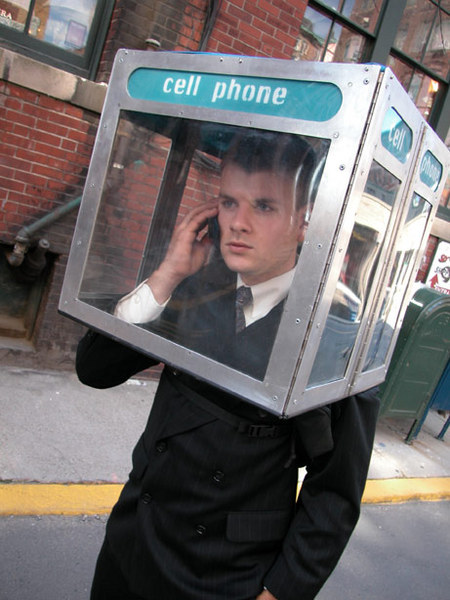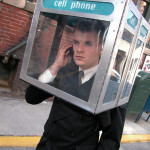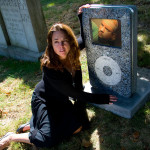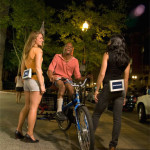By CAROLYN FRANKLIN
I first saw Nick Rodrigues work in the form of a postcard, which showed him in a suit and tie, walking down the street talking on a cellphone with his "Portable Cellular Phone Booth" over his head. It was immediately funny and easy to understand, but each time I looked at that postcard tacked to my wall I realized that there was a lot more depth than I had initially perceived. In many ways, the "Portable Cellular Phone Booth" is the key to understanding Rodrigues whole body of work.
The phone booth is obsolete, for many reasons. The most obvious of these is the increasing ubiquity of the cell phone, but that is not really the only reason that it has faded into the past. The phone booth represents privacy, discretion, and the idea that a person might want to do something that cannot be heard by others. Our current pop culture, however, celebrates publicity, living every moment of life as public as possible, as if we are each the star of our own self-produced "reality" show and we must be available for the cameras at all times. We have the most personal conversations in public for all to hear, we post our every thought to blogs and live journals, and indulge each impulse to make ourselves seen and heard.
Rodrigues "Portable Cellular Phone Booth" makes all of this visible by overlapping the old and the new, both in form and ideology. Not only is it absurd to wear a phone booth on one's head while talking, it is equally as absurd to think that, in our current cultural moment, someone would want to talk on their phone without being heard.
The new exhibition of work by Rodrigues is titled "Hi", an acronym for the "Human Interaction" series. This handful of works explore many aspects of our relationship to our technology and, like the "Portable Cellular Phone Booth", they are both humourous and rich with broader, winking subtext. Take, for example, his "Automotive Armor", a small car that one wears over their head and torso as they go about their business. On his website, Rodrigues writes of the piece: "What if we could act the same way on foot as we do in the car? Cut off old ladies, honk the horn when there's a green light and of course yell anything you want from the protection of your car. This piece Automotive Armor is a way to look at behavior patterns towards each other in the car verses face to face."
Here Rodrigues has taken the expectation of what a viewer is supposed to exerience - the performer wearing the sculpture - and turned it around. To understand the piece, we must imagine wearing it, and confront our behavior inside our cars. To see Rodrigues wearing his mini-car and being a jerk reminds us that, all too often, we act in ways we know we shouldn't because we feel protected in our vehicles, kings of our tiny patch of road.
Many of the pieces in this exhibition reference the iPod as a form, and rely heavily on the larger implications of this device that is nearly as common as the cell phone. The "diePod", for example, is a marble grave marker in the form of an iPod that shows video of the deceased set to their favorite sound track. The "Porta Party" is a giant iPod large enough to fit three or four people, with blaring music and a disco ball.
The "Porta Party", like the "Portable Cellular Phone Booth", creates some very interesting reversals of expectation. With its obvious nod to the "porta potty", one is forced to consider the history of that invention, and the moments when one needs privacy in a public place, and the types of sites (concerts, construction sites, and other forms of temporary spaces) where one would find a portable toilet. As with his other work, Rodrigues posits that since our lives have become wholly public, it is ridiculous to desire or seek privacy for our parties. Parties should be public displays of our grandeur, the highlight of our "reality" show life, and the idea that one would seek a private space for such a moment is inconceivable. Conversely, one might also wonder, since so many activities that once were considered private have gone public, why anyone seeks privacy in a public toilet.
- Nick Rodrigues, Portable Cellular Phone Booth, 2002
- Nick Rodrigues, diePod, 2007
- Nick Rodrigues, Assvertisements, LED screens worn on belt, 2007
"Gabriel & Gilberto Colaço + Nick Rodrigues" is on view October 18 - November 08, 2007 at The Rhys Gallery.
All images are courtesy of the artist and The Rhys Gallery.







